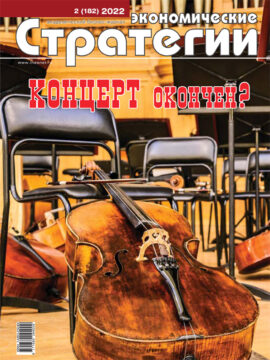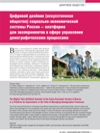The Digital Twin (Artificial Society) of the Socio-Economic System of Russia is a Platform for Experiments in the Field of Managing Demographic Processes
DOI: https://doi.org/10.33917/es-2.182.2022.6-19
One of the most promising tools for monitoring and predicting social processes are agent-based models, which are widely used abroad. Their advantage lies in the consideration of the system under study at the level of its individual individuals, which increases the realism of these computer-based assessment methods. In Russia, this direction is also developing, although not so actively. The article discusses the dynamics of the population of Russia, as well as the factors of increasing the birth rate, successful examples of the practical implementation of agent models for studying social processes, a brief description of the model we developed, which includes 146 million agents, is given. With the help of this tool, a forecast of the population of Russia and an assessment of the impact on this indicator of some measures aimed at improving the demographic situation were obtained.
Источники:
1. Makarov V.L., Bakhtizin A.R., Il’in N.I. Modelirovanie i otsenka natsional’noi sily Rossii [Modeling and Assessing the National Strength of Russia]. Ekonomicheskie strategii, 2020, no 2, pp. 6–19, available at: DOI: https://doi.org/10.33917/es-2.168.2020.6-19.
2. Makarov V.L., Bakhtizin A.R., Il’in N.I., Sushko E.D. Natsional’naya bezopasnost’ Rossii [National Security of Russia]. Ekonomicheskie strategii, 2020, no 5, pp. 6–23, available at: DOI: https://doi.org/10.33917/es-5.171.2020.6-23.
3. Andreev E.M., Darskii L.E., Khar’kova T.L. Naselenie Sovetskogo Soyuza: 1922–1991 [Population of the Soviet Union: 1922–1991]. Moscow, Nauka, 1993, 143 p.
4. Federal’naya sluzhba gosudarstvennoi statistiki [Federal State Statistics Service], available at: https://rosstat.gov.ru.
5. Zdravookhranenie [Healthcare]. Federal’naya sluzhba gosudarstvennoi statistiki, available at: https://rosstat.gov.ru/folder/13721.
6. Sobotka T., Matysiak A., Brzozowska Z. Policy responses to low fertility: How effective are they? Working Paper, May, 2019, N 1, available at: https://www.unfpa.org/sites/default/files/pub-pdf/Policy_responses_low_fertility_UNFPA_WP_Final_corrections_7Feb2020_CLEAN.pdf.
7. The World Bank, available at: https://data.worldbank.org.
8. Aganbegyan A.G. O katastroficheskom uvelichenii smertnosti i merakh po sberezheniyu naroda v Rossii [On Catastrophic Increase in Mortality and Measures to Save the People in Russia]. Ekonomicheskie strategii, 2021, no 4, pp. 6–13, available at: DOI: https://doi.org/10.33917/es-4.178.2021.6-13.
9. Country Comparisons — Death Rate. The World Factbook, available at: https://www.cia.gov/the-world-factbook/field/death-rate/country-comparison.
10. Goldstein J.R., Koulovatianos C., Li J., Schr der C. Evaluating how child allowances and daycare subsidies affect fertility. Goethe University Frankfurt am Main, available at: http://nbn-resolving.de/urn:nbn:de:hebis:30:3-430067.
11. Kalwij A. The impact of family policy expenditure on fertility in western Europe. Demography, 2010, N 47(2), pp. 503–519, available at: DOI: https://doi.org/10.1353/dem.0.0104.
12. Baizan P., Arpino B., Delcl s C.E. The Effect of Gender Policies on Fertility: The Moderating Role of Education and Normative Context. European Journal of Population, 2016, N 32, pp. 1–30, available at: DOI: https://doi.org/10.1007/s10680-015-9356-y.
13. De Geyter C., Calhaz-Jorge C., Kupka M.S., Wyns C., Mocanu E., Motrenko T., Scaravelli G., Smeenk J., Vidakovic S., Goossens V. ART in Europe, 2014: results generated from European registries by ESHRE. The European IVF-monitoring Consortium (EIM) for the European Society of Human Reproduction and Embryology (ESHRE). Hum Reprod, 2018, N 33(9), pp. 1586–1601, available at: DOI: https://doi.org/10.1093/humrep/dey242. PMID: 30032255.
14. Soare F.S. Ceausescu’s population policy: a moral or an economic choice between compulsory and voluntary incentivised motherhood? European Journal of Government and Economics, 2013, N. 2(1), pp. 59–78, available at: DOI: https://doi.org/10.17979/ejge.2013.2.1.4287.
15. Kulu H., Boyle P.J., Andersson G. High suburban fertility: Evidence from four Northern European countries. Demographic Research, 2009, N 21, pp. 915–944, available at: http://www.jstor.org/stable/26349367.
16. Adsera A. Education and fertility in the context of rising inequality. Vienna Yearbook of Population Research, available at: https://EconPapers.repec.org/RePEc:vid:yearbk:v:15:y:2017:i:1:p:063-94.
17. Fahl n S., Olбh L.S. Economic uncertainty and first-birth intentions in Europe. Demographic Research, 2018, N 39(28), pp. 795–834, available at: DOI: https://doi.org/10.4054/DemRes.2018.39.28.
18. Barbieri P., Bozzon R., Scherer S., Grotti R., Lugo M. The Rise of a Latin Model? Family and fertility consequences of employment instability in Italy and Spain. European Societies, 2015, available at: DOI: https://doi.org/10.1080/14616696.2015.1064147.
19. Goldin C. The Quiet Revolution That Transformed Women’s Employment, Education, and Family. American Economic Review, 2006, available at: DOI: https://doi.org/10.1257/000282806777212350.
20. Mulder C.H., Billari F.C. Homeownership Regimes and Low Fertility. Housing Studies, 2010, available at: DOI: https://doi.org/10.1080/02673031003711469.
21. Mulder C.H. Home-ownership and family formation. Journal of Housing and the Built Environment, 2006, vol. 21, N 3, pp. 281–298, available at: http://www.jstor.org/stable/41107349.
22. Billingsley S. The Post-Communist Fertility Puzzle. Population Research and Policy Review, 2010, vol. 29, N 2, pp. 193–231, available at: http://www.jstor.org/stable/40608425.
23. Beaujouan ., Sobotka T. Late childbearing continues to increase in developed countries. Population & Societies, 2019, available at: https://www.ined.fr/fichier/s_rubrique/28820/562.ang.web_1.en.pdf.
24. How to Fix the Baby Bust. FP, available at: https://foreignpolicy.com/2019/07/25/how-to-fix-the-baby-bust/
25. Free preschool education raises concerns over run on nurseries. The JapanTimes, available at: https://www.japantimes.co.jp/news/2019/10/08/national/politics-diplomacy/free-preschool-education-raises-concerns-run-nurseries/
26. Japan’s Births Decline To Lowest Number On Record, NPR, available at: https://www.npr.org/2019/12/24/791132555/japans-births-decline-to-lowestnumber-on-record.
27. Th venon O. The Influence of Family Policies on Fertility in France: Lessons from the Past and Prospects for the Future. In: Rindfuss R., Choe M. (eds) Low Fertility, Institutions, and their Policies. Springer, Cham, 2016, available at: DOI: https://doi.org/10.1007/978-3-319-32997-0_3.
28. Kashyap R., Villavicencio F. An Agent-Based Model of Sex Ratio at Birth Distortions. In: Grow A., Van Bavel J. (eds) Agent-Based Modelling in Population Studies. The Springer Series on Demographic Methods and Population Analysis, 2017, vol. 41, available at: DOI: https://doi.org/10.1007/978-3-319-32283-4_12.
29. Kl sener S., Scalone F., Dribe M. Exploring the Role of Communication in Shaping Fertility Transition Patterns in Space and Time. In: Grow A., Van Bavel J. (eds) Agent-Based Modelling in Population Studies. The Springer Series on Demographic Methods and Population Analysis, 2017, vol. 41, available at: DOI: https://doi.org/10.1007/978-3-319-32283-4_13.
30. Ciganda D., Villavicencio F. Feedback Mechanisms in the Postponement of Fertility in Spain. In: Grow A., Van Bavel J. (eds) Agent-Based Modelling in Population Studies. The Springer Series on Demographic Methods and Population Analysis, 2017, vol. 41, available at: DOI: https://doi.org/10.1007/978-3-319-32283-4_14.
31. Brinton M.C., Zhou Y. Low Fertility in Japan: An Agent-Based Modeling Approach. Population Association of America, available at: http://paa2019.populationassociation.org/abstracts/191755.
32. Makarov V.L., Bakhtizin A.R., Sushko E.D., Sushko G.B. Modelirovanie sotsial’nykh protsessov na superkomp’yuterakh: novye tekhnologii [Modeling Social Processes on Supercomputers: New Technologies]. Vestnik Rossiiskoi akademii nauk, 2018, vol. 88, no 6, pp. 508–518, available at: DOI: https://doi.org/10.7868/S086958731806004X.
33. Bakhtizin A.R., Makarov V.L., Maksakov A.A., Sushko E.D. Demograficheskaya agent-orientirovannaya model’ Rossii i otsenka ee primenimosti dlya resheniya prakticheskikh upravlencheskikh zadach [Demographic Agent-based Model of Russia and Assessment of Its Applicability for Solving Practical Management Problems]. Iskusstvennye obshchestva, 2021, vol. 16, vyp. 2, available at: DOI: https://doi.org/10.18254/S207751800015357-1.



